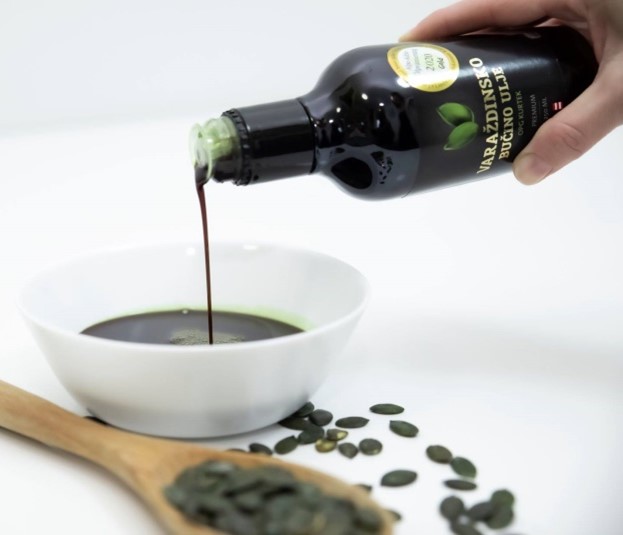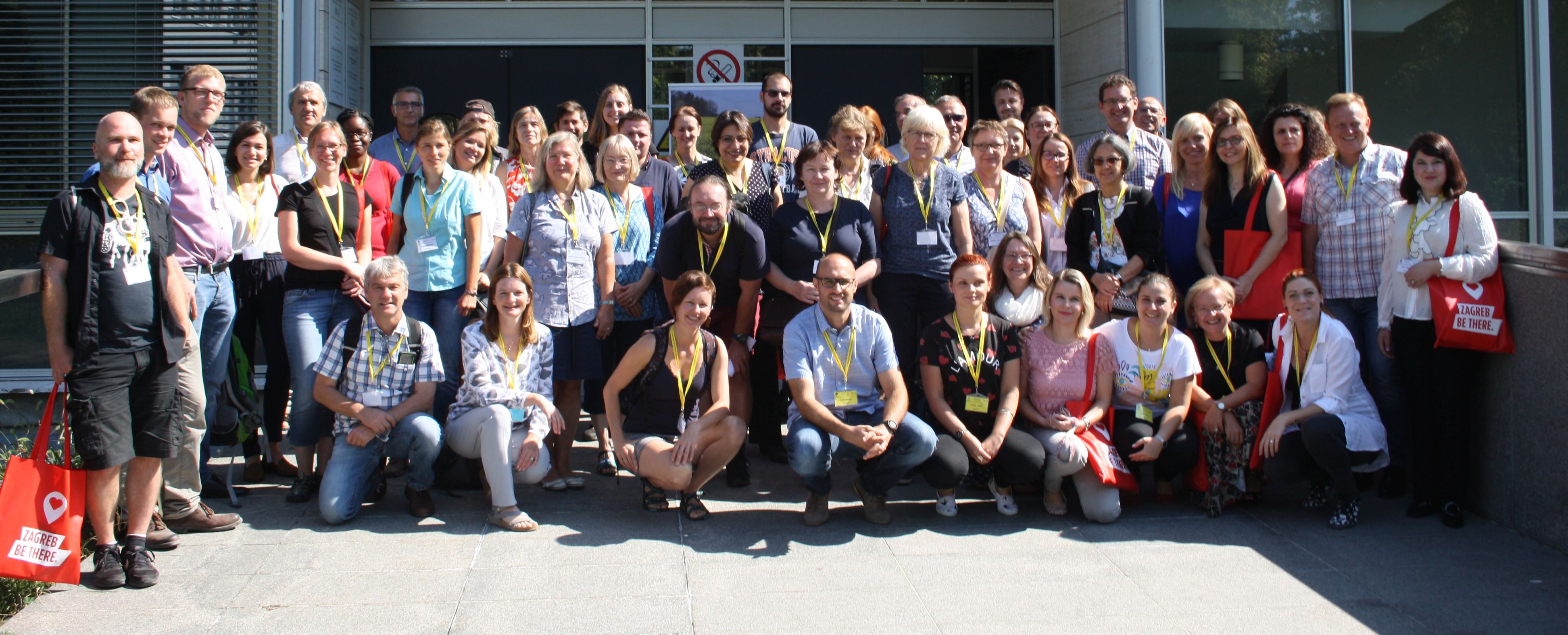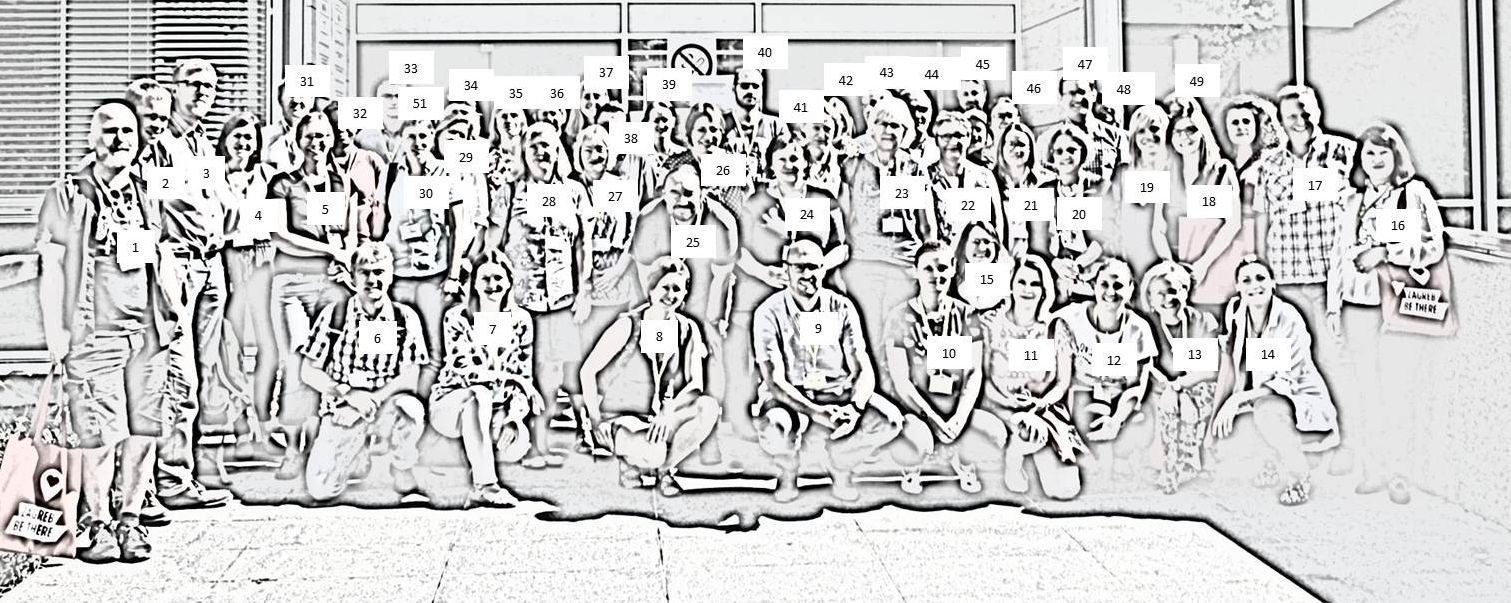WG meeting 2018 in Zagreb, Croatia
Summary of the 17th biannual meeting of the IOBC Working Group on Integrated Control in Oilseed Crops
The IOBC Working Group on Integrated Control in Oilseed Crops (ICOC) met for the 17th time in Zagreb, Croatia on September 18-20, 2018. The meeting was held at the Faculty of Agriculture of the University of Zagreb. The aim of the biannual meeting of our WG was to discuss the current problems encountered in the production of oilseed crops in Europe. The problems with pests and diseases, resulting in crop damage and yield loss observed by us in Europe are very similar to those reported in the other parts of the world. In Croatia, we met its own specialty, the production of pumpkin seed oil and we had an opportunity to try this specialty. Pumpkin seed oil (Figure 1a) is rich in heart-healthy fats and antioxidants. Numerous studies have shown its positive effect on heart and urinary tract condition, but it was also demonstrated that it can increase hair growth! As such, it is not only used as raw and cooking oil for consumption or diet supplement, but also its applied to the scalp is promoted. This aspect of the use of an oil plant has never been raised at our meetings before!
This year we also met the newcomer to our ICOC Working Group: oil hemp (Figure 1-right). Plant breeders obtained dioecious and monoecious hemps, free from psychoactive compounds, but producing big quantities of seeds with interesting oil composition. Unfortunately, these oilseeds also have many enemies, among them insects, fungi, bacteria and viruses; moreover they are also loved by birds!


Figure 1. Newcomer oilseed crops in the studies of the IOBC Working Group on Integrated Control in Oilseed Crops: Left - pumpkin seed oil (Croatia); Right - oilseed hemp (Poland).
The meeting comprised both joint and separate sessions devoted to entomology and plant pathology of oilseed crops, with the final get-together summarizing our respective discussions. In such a way, we not only discussed the technical and experimental details of our work in subgroups of specialists, but also shared the most current knowledge on problems in oilseed production with the specialists of the other sub-group. In this way we were double winners, as we could dwell on very detailed aspects of studies that interest us in either entomology or plant pathology, without losing much of the general picture. In total there were 52 contributions, including 48 oral presentations and 4 posters.
As usual, the main crop discussed was oilseed rape, OSR (Brassica napus) – an amazingly versatile crop grown on all continents, from Europe through Asia to North America and Australia. Based on EuroStat data, in 2015 Europe was still the world’s leader with 21.7 million tons harvested, representing nearly 70% of global production. However, the leading position may be lost, if we do not manage to counteract the yield losses due to increasing pest damages. Against this background, both sub-groups discussed methods for ecology-based IPM strategies that can be realized and that are currently viewed as a need, not just an option.
Current problems discussed by plant pathologists primarily concerned clubroot of OSR caused by Plasmodiophora brassicae. Quantitative resistance to clubroot and interactions with abiotic stress was discussed at the joint session of plant pathologists and entomologists. Then, numerous presentations on clubroot occupied one whole day of plant pathology sessions. The overview of clubroot incidence and pathotypes in several European countries was presented. It was demonstrated that clubroot of oilseed rape is a disease of increasing economic importance in Europe. The highest clubroot infestation occurred in fields where OSR was growing at shorter rotations. Clubroot was found in soils exhibiting a wide pH range from 4.4 up t 8.1, but acidic soils were most at risk. The majority of isolates in EU according to Somé pathotyping system belonged to the pathotypes 1 and 3, with pathotypes 2, 5 and 6 in the minority. However, pathotypes 1 and 3 belonged to different ECD triplet codes of the Buczacki system, what demonstrated high variation of the pathogenicity of P. brassicae populations. Moreover, from all EU populations tested for virulence on cv. Mendel, several isolates were moderately or highly virulent, what suggested that the ‘Mendel’ resistance, called also ‘the first generation resistance’ may be soon overcome. Thorough studies of biocontrol agents, including known biocontrol agent Clonostachys rosea and endophyte Acremonium alternatum. Both fungi induced plant defense mechanisms and they were suggested as useful constituents of seed coating or soil amendment. Biocontrol potential by the apathogenic A1/D2 lineage of V. longisporum against pathogenic strains of this species and their interaction with roots of OSR were also discussed. It was found that V. longisporum lineage A1/D1 was dominant in European and Canadian oilseed rape fields, so differences in pathogen populations could not explain the diversity in disease severity between fields. Moreover, no significant correlation between disease severity and soil inoculum has been found.
As interesting proposal of introducing the resistance to soil pathogens concerned strengthening of the root system using mepiquat chloride. Another proposal of integrated clubroot control was combining plant resistance with the use of calcium cyanamide or burnt lime. A few presentations were devoted to host resistance to clubroot, using interspecific hybrids of Brassica crops, as well as other sources of resistance, such as oil radish (Raphanus sativus). Only one, very rare isolate, that can overcome the ‘Raphanus resistance’ has been found by now.
Studies were undertaken to develop a concept for integrated control of clubroot in winter OSR crops supported by DNA-technology by examining and comparing infestation levels and yield of resistant and susceptible varieties grown in fields with different infection levels of P. brassicae. Fields were successfully identified by qPCR. Seeding at a soil temperature of 20⁰C generated higher infection levels of susceptible cultivars as compared to seeding at 14⁰C despite considerably higher inoculum levels of P. brassicae. The reaction of different resistant cultivars was similar but significantly different from susceptible cultivars. The analysis of gene expression in different root tissues of clubroot infected plants revealed great differences between the symptomless and symptom-bearing parts of roots, with salicylic acid pathway and PR protein genes expression in the former, and jasmonic acid in the latter, respectively.
Problems with the other damaging disease of OSR, called blackleg or stem canker of oilseed rape have partially been overcome by the introduction of the Rlm resistance genes and the current step is to combine them with quantitative resistance to biotic and abiotic stress. Also, new molecular techniques, based on Next Generation Sequencing were presented to enable quantification of the pathogens in plant tissues as well as in the soil. The studies focused on new races, pathotypes, lineages as well as resistances to current chemistry and resistance genes which pose new threats to OSR production. Apart from clubroot and blackleg, several presentations concerned Sclerotinia stem rot, its molecular detection and chemical control using fungicides as well as gaining resistance by numerous isolates of S. sclerotiorum to boscalid, successfully used to control this disease by now. The loss of susceptibility to boscalid was due to two single target mutations SdhD-H132R and SdhC-H146R. Singly or jointly they are responsible for SDHI resistance development in S. sclerotiorum.
At this meeting entomologists dwelled on the increasing pressure on insecticidal active ingredients; on one hand the continued development of pest resistance to available compounds and on the other, revocation of the neonicotinoid seed treatments by the EU. Currently, many farmers are giving up growing oilseed rape due to problems with cabbage stem flee beetle and other pests. One of the aims of ICOC WG activities is the development of sustainable, alternative control strategies for insect pests of oilseeds that minimize insecticide use and reduce the risk of resistance...
The meeting of our WG in Zagreb gathered 60 participants from 28 institutions coming from 14 countries, including Austria (1), Croatia (15), Czech Republic (9), Denmark (2), Estonia (1), France (6), Germany (11), Poland (5), Sweden (1), Switzerland (2) and the United Kingdom (7). Ten PhD students attended the meeting some coming from Iraq (1), Nigeria (1), Kurdistan (1) studying in Europe.
We are greatful to the following sponsors of the meeting: University of Zagreb Faculty of Agriculture, Zagreb Tourist Board, City of Zagreb Department for Agriculture and Forestry; BASF (Croatia/Germany); Rothamsted Research (UK); Institute for Plant Genetics Poland.
The very important part of each meeting is to establish friendships and new connections between the researchers. During our stay we could visit the Trakošćan Castle, located 80 km north of Zagreb, in the Varaždin County, close to the border with Slovenia. The castle dates back to the 13th century. We could also socialize in local vineyards and listen to unusual vocal skills of Dr Ivan Juran, the main local organizer of the meeting!
Thanks Ivan, we will miss blue skies, tasty dense pumpking oils and great hospitality of Croatian citizens. Looking forward to the next meeting in the near future!
Participants of the meeting

Click on images to enlarge in a separate tab

Click on images to enlarge in a separate tab
| No. | Name | Institution |
| 1 | Arne Schwelm | Innsbruck University Austria/ SLU Uppsala, Sweden |
| 2 | Johannes Hausmann | Julius Kühn Institute, Braunschweig, Germany |
| 3 | Nils Conrad | Julius Kühn Institute, Braunschweig, Germany |
| 4 | Marta Vega Marin | Georg-August-University Göttingen, Germany |
| 5 | Franziska Beran | Max Planck Institute for Chemical Ecology, Jena, Germany |
| 6 | Birger Koopmann | Georg-August-University Göttingen, Germany |
| 7 | Sam Cook | Rothamsted Research, Harpenden, UK |
| 8 | Stephanka Radova | Central Institute for Supervising and Testing in Agriculture, Brno, Czech Republic |
| 9 | Ivan Juran | University of Zagreb, Faculty of Agriculture, Zagreb, Croatia |
| 10 | Daria Lemic | University of Zagreb, Faculty of Agriculture, Zagreb, Croatia |
| 11 | Ivana Pajac Zivkovic | University of Zagreb, Faculty of Agriculture, Zagreb, Croatia |
| 12 | Maja Cacija | University of Zagreb, Faculty of Agriculture, Zagreb, Croatia |
| 13 | Renata Bazok | University of Zagreb, Faculty of Agriculture, Zagreb, Croatia |
| 14 | Helena Viric Gasparic | University of Zagreb, Faculty of Agriculture, Zagreb, Croatia |
| 15 | Malgorzata Jedryczka | Institute of Plant Genetics, Polish Academy of Sciences, Poznan, Poland |
| 16 | Noor Ramzi | Institute of Plant Genetics, Polish Academy of Sciences, Poznan, Poland |
| 17 | Andrzej Brachaczek | Innvigo, Warsaw, Poland |
| 18 | Janetta Niemann | Poznań University of Life Sciences, Poznań , Poland |
| 19 | Joanna Kaczmarek | Institute of Plant Genetics, Polish Academy of Sciences, Poznan, Poland |
| 20 | Annette Penaud | Terres Inovia, Thiverval-Grignon, France |
| 21 | Marina Brčić | University of Zagreb, Faculty of Agriculture, Zagreb, Croatia |
| 22 | Régine Delourme | INRA IGEPP, Le Rheu, France |
| 23 | Ann-Charlotte Wallenhammar | Rural Economy and Agricultural Society, Orebro, Sweden |
| 24 | Eva Plachka | OSEVA Development and Research Ltd., Zubri, Czech Republic |
| 25 | Marek Seidenglanz | Agritec Plant Research l.t.d., Šumperk, Czech Republic |
| 26 | Anne Nazanin Zamani-Noor | Julius Kühn-Institut (JKI), Institute for Plant Protection in Field Crops and Grassland, Braunschweig, Germany |
| 27 | Caroline Young | RSK ADAS Ltd, Stratford on Avon, United Kingdom |
| 28 | Jutta Ludwig-Müller | Technische Universität Dresden, Dresden, Germany |
| 29 | Veronika Konradyova | Czech University of Life Sciences, Prague, Czech Republic |
| 30 | Meike Brandes | Julius Kühn-Institut, Braunschweig, Germany |
| 31 | Pavel Rysanek | Czech University of Life Sciences, Department of Plant Protection, Prague, Czech Republic |
| 32 | Olufadekemi Fajemisin | Czech University of Life Sciences Prague, Prague, Czech Republic |
| 33 | Luc Westerloppe | Gowan Crop Protection Ltd, Touch, France |
| 34 | Christian Benjamin Andersen | University of Copenhagen, Copenhagen, Denmark |
| 35 | Birgit Jensen | University of Copenhagen, Frederiksberg C, Denmark |
| 36 | Sacha White | ADAS, Boxworth, Cambridge, United Kingdom |
| 37 | Jana Mázákova | Czech University of Life Sciences, Prague, Czech Republic |
| 38 | Jaroslav Šafář | Agritec Plant Research, Šumperk, Czech Republic |
| 39 | Julie Andrea Smith | RSK ADAS, Rosemaund, Hereford, United Kingdom |
| 40 | Jonathan Willow | Estonian University of Life Sciences, Tartu,Estonia |
| 41 | Elke Diederichsen | Freie Universität Berlin, Berlin, Germany |
| 42 | Deborah Kaiser | Agroscope/ Federal Department of Economic Affairs, Education and Research/ Ecological Plant Protection in arable crops, Zurich, Switzerland |
| 43 | Bernd Ulber | University of Goettingen, DNPW, Agricultural Entomology, Goettingen, Germany |
| 44 | Laurent Ruck | Terres Inovia, Chalons en Champagne, France |
| 45 | Aleksandar Mešić | University of Zagreb, Faculty of Agriculture, Zagreb, Croatia |
| 46 | Lenka Burketová | Institute of Experimental Botany AS CR, Prague, Czech Republic |
| 47 | Giselher Grabenweger | Agroscop, Zurich, Switzerland |
| 48 | Wolfgang Büchs | Federal Research Centre of Cultivated Plants, Braunschweig, Germany |
| 49 | Celine Robert | Terres Inovia, Thiverval-Grignon, France |
| 50 | Celine Robert | Terres Inovia, France |
| Registered people not in the photo | ||
| 50 | Tanja Gotlin Čuljak | University of Zagreb, Faculty of Agriculture, Zagreb, Croatia |
| 51 | Dima Alnajar | Georg-August-University, Department of Crop Sciences, Plant Pathology and Crop Protection Division, Göttingen, Germany |
| 52 | Nikoleta Rubil | University of Zagreb, Faculty of Agriculture, Zagreb, Croatia |
| 53 | Anita Štivičić | University of Zagreb, Faculty of Agriculture, Zagreb, Croatia |
| 54 | Nicolas Sender | Novozymes, Le Pecq, France |
| 55 | Marcus Marvin | Novozymes, Nottingham, United Kingdom |
| 56 | Shuvash Bhattarai | Novozymes, Nottingham, United Kingdom |
| 57 | Georgia Mitrousia | University of Hertfordshire, Hatfield, United Kingdom |



